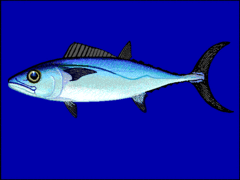- Dogtooth tuna
-
Dogtooth tuna 
Scientific classification Kingdom: Animalia Phylum: Chordata Class: Actinopterygii Order: Perciformes Family: Scombridae Tribe: Sardini Genus: Gymnosarda
Gill, 1862Species: G. unicolor Binomial name Gymnosarda unicolor
(Rüppell, 1836)The dogtooth tuna is a large fast-swimming fish in the family Scombridae. It is placed in its own genus, Gymnosarda. It has the large teeth and straight edged first dorsal fin characteristic of the smaller bonitos (genus Sarda) and although it far exceeds them in size, reaching weights of over 150 kilograms, is considered more closely related to them than to the true tunas. The fish is known in Samoa and some other Pacific nations as tagi. In Mauritius it is referred to as the thon blanc, or white tuna. Its range extends from the Marshall Islands to the western Indian Ocean and as far north as southern Japan and South Korea, where the long-standing world record of 288 lbs was caught.
Dogtooth tuna frequent reef environments, with smaller fish being more commonly found near shallow reef areas and larger ones haunting deep reef drop off areas, seamounts and steep underwater walls. The dogtooth tuna is one of the apex non-pelagic predators in its environment, sharing that position with Giant Trevally, Napoleon Wrasse, and large groupers, as well as reef, bull and tiger sharks. An aggressive predator, the dogtooth tuna is an opportunistic feeder that is capable of taking a wide variety of prey items. In most areas the mainstay of its diet probably consists of pelagic schooling fish found near reef habitat, including fusiliers, carangids such as rainbow runners and mackerel scad, and scombrids.
The dogtooth tuna is appreciated in most of its range as a fine food fish and also as a game fish sought by both rod and reel anglers and spearfishermen. Dogtooth tuna used to be mostly taken as an incidental catch by anglers trolling for other gamefish - with natural baits for black marlin, for instance, or with lures for wahoo and Spanish (narrowbarred) mackerel. In the last 10 to 15 years there has been more dedicated effort directed at this species because of its rarity and sporting qualities. Dogtooth tuna are now a highly coveted prize by many European and Asian sports anglers. Large specimens are seldom found where there is significant fishing pressure and can be one of the most difficult gamefish to capture. Their habit of making high-speed downward runs when hooked, even on heavy tackle, often sees the line being cut as it contacts deep bottom structure. Sharks frequently mutilate both hooked and speared fish during the later stages of the fight, adding to the difficulty in landing them. The majority of dogtooth tuna captures have tended to be made by trolling with dead and live baits or with lures, particularly deep-swimming plugs. These techniques are still often used, with one niche specialty being the use of live bait such as rainbow runners to tease dogtooth tuna within range of light tackle and fly-casting anglers. High speed jigging with a variety of metal lures has increased tremendously in popularity in the last several years as advancements in tackle technology have resulted in lightweight rods and reels that are capable of handling heavy spectra-type braided lines. Some of the more popular destinations for anglers seeking this species include Okinawa and other islands of southern Japan, Rodrigues and other Indian Ocean islands such as the Maldives, Bali and elsewhere in Nusa Tenggara in Indonesia, the Great Barrier Reef and its outlying atolls, and many Western Pacific islands such as Vanuatu, Fiji, Tonga and Samoa.
Here is a picture of a smaller one [1]
References
- "Gymnosarda unicolor". Integrated Taxonomic Information System. http://www.itis.gov/servlet/SingleRpt/SingleRpt?search_topic=TSN&search_value=172469. Retrieved 18 April 2006.
- Froese, Rainer, and Daniel Pauly, eds. (2006). "Gymnosarda unicolor" in FishBase. January 2006 version.
Categories:
Wikimedia Foundation. 2010.
